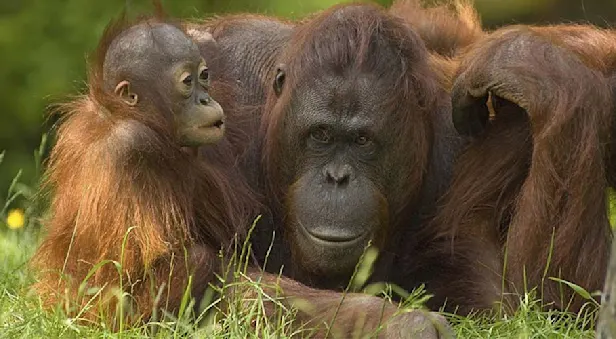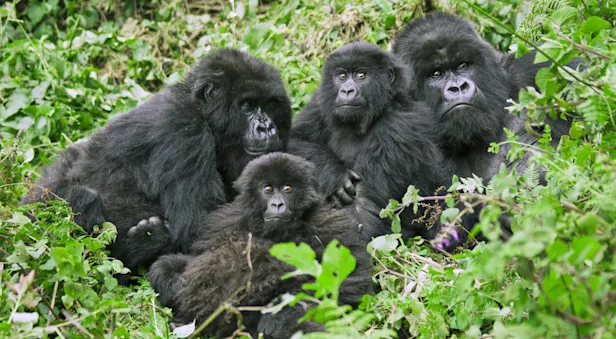Know Before You Go
Bornean Orangutan Facts | Borneo Wildlife Guide
Bornean orangutans (Pongo pygmaeus) are an endangered great ape found only in Borneo. No orangutans live in the southeastern portion of the island, and there are three subspecies found in the northwest, northeast and central regions. Northwest Bornean orangutans are the smallest, most threatened population, with only approximately 1,500 individuals remaining, while Central Bornean orangutans are the largest group, comprising about 35,000 members.
Biology
Fossil evidence reveals that these orangutans were once found throughout Southeast Asia. Bornean orangutans and Sumatran orangutans were thought to be merely subspecies until 1996, when the Sumatran orangutan was classified as a separate species. As recently as 2017, the Tapanuli orangutan of the island of Sumatra was found to be a distinct species and is the most endangered population of all the great apes, composed of no more than 800 individuals.
Habitat
This almost exclusively arboreal species inhabits lowland rainforests, swamps and mountain regions up to 5,000 feet in elevation. Orangutans spend most of their time maneuvering through the trees, agilely walking across and swinging from branches. Comfortable at great heights, they descend to the ground only when they are unable to reach another tree branch from above, or when collecting branches to construct their sleeping nest. At night, they select a tree to build their nest and rest in this platform 40-60 feet above the ground. When rains fall, they will sometimes use large leaves as umbrellas to shelter themselves from the storm.
Physical Characteristics
Bornean orangutans have a thin, shaggy, reddish-brown coat. Long, strong arms allow orangutans to propel themselves through the trees, in contrast to their shorter, weaker legs. Their wide forehead slopes into a protruding snout. Males have large cheek flaps made of fatty tissue, which develop in size throughout their life, showcasing their dominance in the hierarchy.
Feeding Habits
Orangutans feed mainly on fruit, particularly wild figs. The range of an orangutan corresponds with the particular fig species that ripen in different areas throughout the year. Bornean orangutans also incorporate flowering plants, seeds, bark and leaves into their diet, in addition to insects, honey and bird eggs. They obtain water from tree holes, scooping it up and drinking it from their hands, and from water-laden fruits such as durians, lychees and mangosteens.
Behavior & Communication
Bornean orangutans produce approximately 13 vocal sounds. They smack their lips to communicate in small social groups, and it appears they grind their teeth when vexed. When frightened, they emit piercing shrieks, and infants will scream if separated from their mother. Males will occasionally roar, utilizing their large throat pouches. Male orangutans also make a series of groans so loud they can be heard from half a mile away, which may act as a territorial warning in order to keep males spaced apart. Orangutans also communicate using touch, and grooming is a social activity shared by all primates. In addition, body postures, facial expressions, and gestures signal emotions and transfer messages between apes.
Bornean orangutans typically travel alone or in small social groups made up of two females, their dependent offspring, and infrequently an adult male. Typically, males and females are only found together when breeding. A male’s home range, between 1.25 and 3.75 square miles, often overlaps with that of several females, but they are fiercely aggressive toward members of their own sex.
Reproduction
Bornean orangutans are polygynous, the male mating with several females. On the rare occasions females are sexually receptive, they copulate with a dominant, typically solitary male. Male orangutans who are smaller or younger, and are unable to maintain their own home ranges, often roam the forest. Happening upon a female, they may opportunistically force themselves on her, even if she is unreceptive and infertile.
Estrus in female Bornean orangutans lasts 29 to 32 days. Ovulation takes place at approximately day 15, with menstruation occurring for three to four days. Female and male typically face one another during coitus, in an act of suspension as they hang by their arms from tree branches.
Gestation lasts between 233 and 263 days, and the mother usually gives birth to one infant, although sometimes twins are born. Newborns weigh just under 3.5 pounds. Infants nurse every three to four hours, and at 3 to 4 months old they start to eat fruit, which is made soft by their mother who grinds it with her teeth. For one year, the mother will carry her young on her abdomen, the infant clinging to her by entwining its small fingers in her hair. Offspring continue to stay with their mother after the first year, riding on her back until 2.5 years of age. Orangutans are not weaned until they are 3.5 years old.
Females reach puberty and attain full size at 7 years old, but do not have their first young until the ages of 15 or 16. They only give birth about once every eight years—the longest birthing interval of any great ape. Males, on the other hand, reach full growth at 10 years of age and usually cannot successfully mate until they are 15. Orangutans can live into their 60s in captivity and survive between 35 and 45 years in the wild.
Conservation
Bornean orangutans are threatened by deforestation and logging, which is eradicating their habitat, in addition to poaching and capture for the illegal wildlife trade. Their numbers continue to plummet as their range shrinks, despite protections by international law. There are an estimated 104,700 Bornean orangutans left in the wild.
Header Credit: Brad Josephs
See Apes on These Nature Safaris

The Wilds of Borneo: Orangutans & Beyond
Plumb some of the world’s oldest and tallest rainforests in search of wild orangutans and other jungle wildlife among diverse ecosystems on this matchless tropical nature adventure.

























